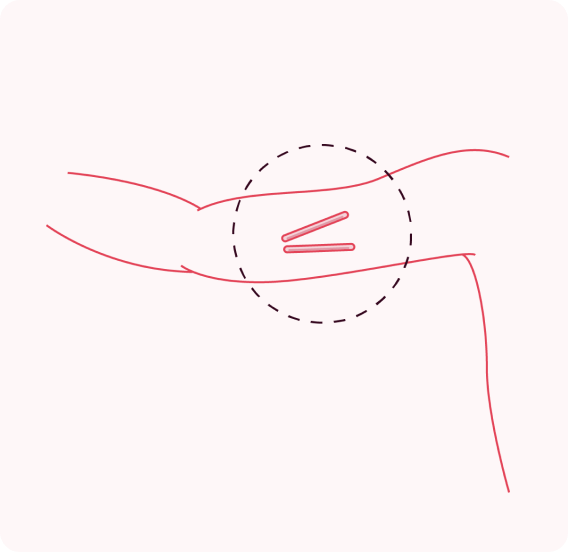More than 99% effective – one of the most effective forms of contraception. A Fit & Forget Contraception. The implant, sometimes known as “rods”, are two small implants placed under the skin in the upper arm.

The contraceptive implant is two small, flexible plastic rods that are placed just under the skin in the upper arm. It releases the hormone progestogen to prevent pregnancy. Jadelle is the funded implant available in New Zealand.
The implant releases a hormone (progestogen) similar to the hormone that is produced naturally in the ovaries. It stops the egg and sperm from meeting.
The implant:
The implant can be put in at any time you choose. Additional precautions need to be taken should you have any chance of pregnancy during the implant insertion appointment.
A trained nurse, midwife, or doctor fits it in your upper arm. The picture shows where the implant is fitted in your arm.

There are loads of things about the implant that are good for your body as well as your sex life.
Lots worry about negative side effects, but for many people, they’re not a problem. Most
people adjust to having an implant pretty quickly but give yourself time. It could take a few
months.
An implant needs to be fitted by a nurse, midwife or doctor who has been specially trained. It is available FREE* from a range of services.
The implant is suitable for most people of all ages, including those who are young.
An appointment will typically include:
Fitting the implant (shouldn’t take longer than 5 minutes):
Yes, you can feel it in your arm. But don’t squeeze or play with it. Sometimes that can break
the small plastic rods.
If you can’t feel it, it changes shape, or you notice any changes to your skin or you have pain
where it has been inserted, visit a nurse, midwife, or doctor. Use condoms until you’re sure
it’s protecting you again.
The implant can be left in place for up to five years.
The implant has to be removed by a specially trained nurse, midwife or doctor. They will:
The implant must be replaced every five years and must be replaced at the same time, otherwise you will not be protected from pregnancy.
Some medicines can reduce the effectiveness of the implant, such as those used to treat epilepsy, HIV and tuberculosis (TB) and the complementary medicine St John’s Wort. Commonly used antibiotics do not reduce the effectiveness of the implant, but it is always best to check with the doctor, midwife, nurse or pharmacist first.
Your period can change while the implant is in your body. You might have spotting between periods, or have longer, heavier periods. Some may have irregular bleeding the whole time. Others don’t get periods for a while. Some have regular month periods. It’s a bit uncertain, but most manage irregular or heavy periods well by taking a contraceptive pill.
If bleeding worries you, talk to a nurse, midwife, or doctor. They can give you contraceptive
pills to reduce heavy or regulate irregular bleeding with the implant.
The implant is much more reliable in preventing pregnancy than taking the pill as contraception on its own.

Note: Wāhine/women+ includes consideration of whānau and social context and is intended to be inclusive of gender diverse people who share some of the health needs of women but do not identify as women. (RANZCOG, 2022)
The development of this website was supported with an educational grant from Bayer.
Copyright © Protected&Proud. All Rights Reserved.
A non-hormonal (Copper) IUD is a small, T-shaped plastic device which contains copper. It is put into the uterus (womb). A Copper IUD does not contain hormones. The copper IUD can also be used as an Emergency Contraception.
LASTS FROM 5 TO 10 YEARS | PLACED IN THE UTERUS | EFFECTIVE IMMEDIATELY | EMERGENCY CONTRACEPTION – UP TO 5 DAYS AFTER SEX
A Hormonal IUD is a small, T-shaped plastic device, which contains the hormone progestogen to control your fertility. The device is put into the uterus (womb).
HORMONES | LASTS FROM 3 TO 5 YEARS | PLACED IN THE UTERUS | EFFECTIVE IN 7 DAYS

Two small, flexible plastic rods that are placed just under the skin in the upper arm. The implant releases the hormone progestogen to control fertility.
HORMONES | LASTS UP TO 5 YEARS | PLACED IN THE ARM | EFFECTIVE IN 7 DAYS